
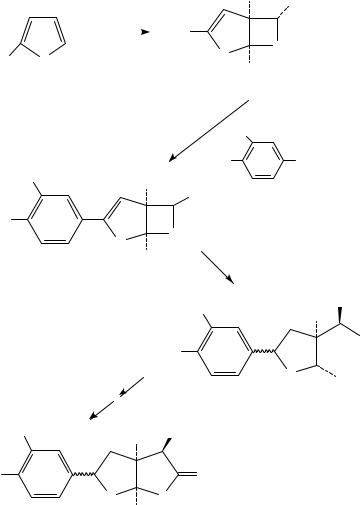
7. Application to the synthesis of complex molecules |
303 |
Bu3 Sn O
MeO
MeO
MeO
MeO
|
|
|
|
H |
CO2 Bu |
|
|
|
|
|
|
||
hν |
|
|
Bu3 Sn |
|
|
|
BuO2 C−CHO |
|
O |
||||
O |
|
|||||
|
|
|
|
|
||
|
|
|
|
H |
|
|
|
|
|
|
(190) |
|
|
|
Pd(PPh3 )4 , THF |
|
|
|||
|
|
|
MeO |
|
||
|
|
|
MeO |
|
Br |
|
|
H |
CO2 Bu |
|
|
||
|
|
|
|
|
||
|
O |
O |
|
|
||
|
1. H |
+ |
|
|||
|
H |
|
||||
(191) |
2. NaBH4 , CeC l3 |
|||||
|
|
|||||
MeO
OH
H
CO2 Bu
MeO
O OH
H OH
O
O O
H
(192)
SCHEME 43
reactions certainly would seem to hold great promise in complex molecule synthesis. It was noted that the oxetane photoadducts produced in these reactions are much more difficult to manipulate and functionalize than their counterparts produced in the intermolecular photocycloaddition. For example, acidic hydrolysis of 193b resulted in retro-[2 C 2]- photocycloaddition rather than the ring opening typically observed in the intermolecular photoadducts. Methods have been developed to circumvent these problems. Epoxidation of 193d and hydrolysis afforded the dione 194. Also, hydrogenation of the enol ether double bond in 193e and subsequent hydrolysis gave the spirocycle 195, again demonstrating the potential of this strategy for the rapid assembly of complex molecular architectures. It is also impressive to note that even highly strained systems (e.g. 193c) can be produced
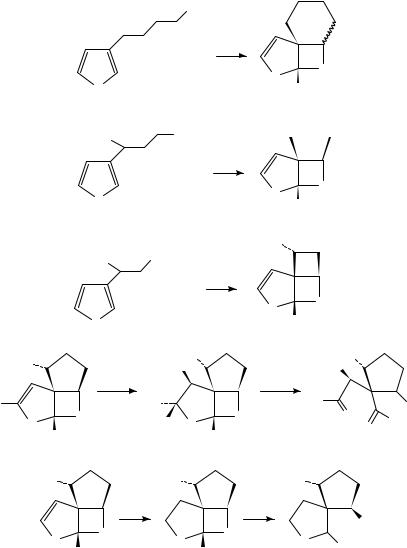
304 |
John M. Nuss and Frederick G. West |
|
CHO |
|
hν |
O |
|
Me |
CHO |
|
|
|
hν |
O |
|
Me |
CHO |
|
|
|
|
|
|
|
|
|
hν |
O |
|
|
|
AcO |
|
AcO |
|
|
HO |
|
|
|
|
|
|
RCO3 H |
|
|
|
Me |
RCO2 |
|
|
O |
Me |
|
O |
O |
O |
|
|
|
|
||
Me |
|
|
Me |
(193d) |
|
|
|
AcO |
AcO |
|
|
H2 |
|
|
|
O |
|
O |
O |
O |
|
|
|
H |
|
|
H |
(193e) |
|
|
|
SCHEME 44
O
O
H
(193a)
Me
O
O
H
(193b)
Me
O
O
H
(193c)
AcO
AcO
1. H+
2. A c2 O |
Me |
OAc |
|
O
Me
O
(194)
AcO
H+
OH
O OH
(195)
with good efficiency. A systematic study of the stereoinduction of substituents on the tether has also been conducted and the reader is referred elsewhere for a more detailed description73c.
Zamojski and coworkers have explored the use of the furan-carbonyl photocycloaddition in asymmetric synthesis, with somewhat limited success88. Irradiation of chiral glyoxylate derivative 196 [RŁ D R -menthyl and (R)( )-8-phenylmenthyl] afforded
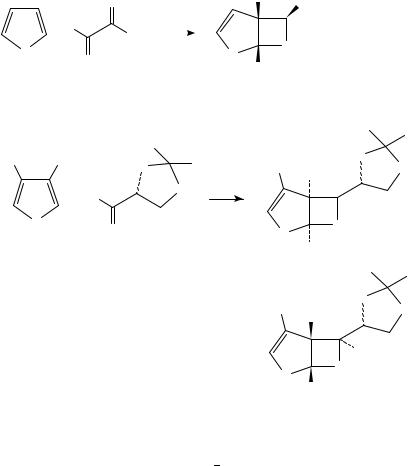
7. Application to the synthesis of complex molecules |
305 |
adducts 197 with low selectivity (7.3% and 15% ee, respectively, after saponification of the ester; Scheme 45). This may be due to a lack of endo or exo selectivity during the photocycloaddition, or to a bad ratio of s-cis and s-trans conformers. Schreiber and Satake also noted low selectivity in the reaction of the protected glyceraldehyde derivative 198 with dimethylfuran as a 1.2:1 mixture of the diastereomeric acetonides 199a and 199b was produced84b; each of these was only ca 50% ee, indicating that this aldehyde may be labile toward racemization under the reaction conditions. Other attempts to react furans with conformationally restricted chiral, nonracemic ketones have met with somewhat better results, but this is still an area that is in development84b.
|
O |
|
|
H |
|
|
|
|
|
|
+ H |
OR* |
hν |
|
|
O |
|
|
O |
|
|
|
O |
|
|
O |
|
|
|
|
|
|
H |
|
|
|
|
|
|
|
(196) |
|
(197) |
|
R* = (−)-menthylde = 7.3% |
|
|
|
|
R* = (−)-8-phenylmenthylde = 15% |
|
|
||
Me |
Me |
O |
|
Me |
|
|
|
||
+ |
H |
|
O |
hν |
|
|
|||
|
|
|
||
O |
|
O |
|
O |
|
|
|
||
|
|
|
|
(198)
Me
+
O
SCHEME 45
CO2 R*
O
O
Me
•
O
H
(199a)
O
O
Me
H
O
H
(199b)
Other aromatic heterocycles undergo Paterno Buchi¨ reaction with carbonyl compounds, although these reactions have seldom been applied to organic synthesis. For example, thiophene reacts cleanly with benzaldehyde to afford a single exo product in 63% yield87. Pyrroles also react with aldehydes and ketones; however, as a result of the lability of the presumed initial cycloadducts, the only products isolated, even with the rigorous exclusion of acid, are the 3-hydroxyalkylpyrroles 200 (equation 7)89.
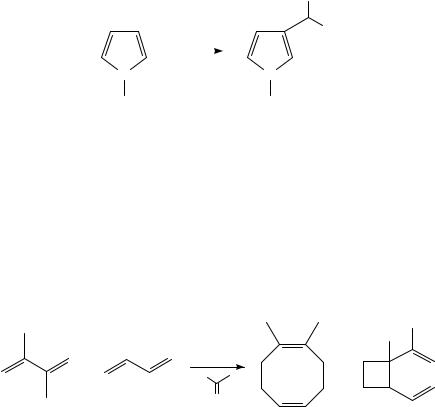
306 |
John M. Nuss and Frederick G. West |
||
|
|
|
OH |
|
|
|
Ph |
|
|
hν |
(7) |
|
|
PhCHO |
|
|
N |
N |
|
|
Me |
Me |
|
(200)
C. [4 + 4]-Photocycloadditions
Photodimerization of simple 1,3-dienes in a 4 C 4 cycloaddition process is typically an inefficient process90. This is not surprising, given the highly ordered transition state for [4C 4]-cycloadditions, and the predominance of the unreactive s-trans conformation70. As a result, as noted above [2 C 2]-cycloadducts are often the major product, accompanied by varying amounts of vinylcyclohexenes and cyclooctadienes. Crossed photocycloadditions employing 1,3-dienes with substituents at the 2- or 3-positions can furnish greater amounts of cyclooctadiene products (equation 8)91. This presumably results from a perturbation of the diene conformational equilibration to provide a higher proportion of the s-cis conformer.
+ |
hν |
+ |
|
Ph |
|||
|
|
||
|
O |
|
|
|
15% |
(8) |
|
|
58% |
As noted previously in Section III.A, the [2 C 2]-cycloadducts formed from 1,3-diene dimerization are divinylcyclobutanes, and thus can potentially serve as precursors to cyclooctadienes via [3,3]-sigmatropic shift. This approach has been exploited by Wender and Correia (Scheme 46)72. Typically, the two diene units were joined by a three-atom tether, improving the efficiency of the photocycloaddition and leading to the generation of a bicyclo[3.2.0]heptane skeleton upon irradiation. Only the cis diastereomer 201a can undergo the subsequent pericyclic process. However, at higher temperatures, the trans isomer 201b also underwent conversion to the desired cyclooctadiene 202, presumably via biradical intermediate. Mattay and coworkers have reported a similar tetraene to divinylcyclobutene process, using Cu(I) salts to preorganize the substrates in a reactive conformation92.
There are a few exceptions to the generalizations made above regarding the periselectivity of 1,3-diene dimerization. These involve systems in which various structural constraints act to impede the typically favored [2 C 2]-cycloaddition process or enhance the [4 C 4]-cycloaddition. For example, cis-9,10-dihydronaphthalene 204a furnished tetracyclic product 205a in good yield (Scheme 47)93. Similarly, propellane 204b underwent conversion to 205b in nearly quantitative yield94. More recently, Srikrishna and Sunderbabu showed that hexahydroanthracene 207, generated in situ from 206 via
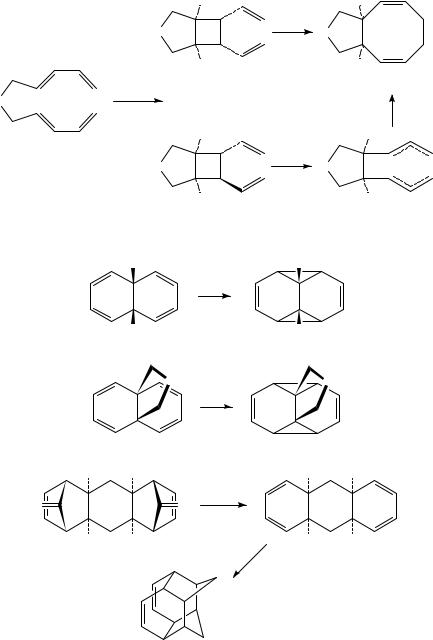
7. Application to the synthesis of complex molecules |
307 |
|||
|
|
H |
|
H |
|
O |
|
130 °C |
|
|
|
O |
|
|
|
|
|
[3,3] |
|
|
|
H |
|
H |
|
|
(201a) |
|
(202) |
O |
hν |
|
|
|
|
|
|
|
|
PhCOPh |
|
|
|
|
|
|
H |
|
H |
|
|
|
200 °C |
• |
|
O |
|
|
|
|
|
O |
• |
|
|
|
|
|
|
|
|
H |
|
H |
|
|
(201b) |
|
(203) |
|
|
SCHEME 46 |
|
|
|
H |
|
H |
|
|
|
hν |
|
|
|
|
65% |
|
|
|
H |
|
H |
|
|
(204a) |
|
(205a) |
|
|
O |
|
O |
|
|
|
hν |
|
|
|
|
95% |
|
|
|
(204b) |
|
(205b) |
|
H |
H |
|
H |
H |
O |
O |
hν |
|
|
(−2 CO) |
|
|
||
|
|
|
|
|
H |
H |
|
H |
H |
(206) |
|
50% |
(207) |
|
|
|
|
hν |
|
(208)
SCHEME 47

308 |
John M. Nuss and Frederick G. West |
photochemical decarbonylation, suffered [4 C 4]-cycloaddition to give pentacyclic adduct 208 (Scheme 47)95.
Another unique example was observed for the recently isolated marine natural product, alteramide A (209), isolated from a symbiotic bacteria (Alteromonas sp.) found on the sponge Halichondria okadai 96. It was found that the tetraene core of this compound underwent intramolecular [4 C 4]-photocycloaddition upon exposure to sunlight (equation 9). Deliberate irradiation led to a quantitative conversion to cyclooctadiene 210.
Et
Me
Et
Me
• |
H |
|
|
H |
|
|
|
|
|||
|
|
|
|
N |
|
• |
|
|
|
|
|
|
• |
|
O O |
||
H |
|
|
OH |
||
HO |
|
|
|
• |
|
|
|
|
|
OH |
|
|
|
|
O |
• |
|
|
|
|
N |
||
|
|
|
|
||
|
|
|
(209) |
H |
|
|
|
|
|
||
|
|
|
hν |
(9) |
|
|
|
|
|
||
• |
H |
|
O |
H |
|
H |
H |
||||
|
N |
||||
• |
|
|
|
HO |
|
|
|
|
|
||
H |
• |
H |
H |
• OH |
|
HO |
|
• |
|||
|
|
O |
|||
|
|
|
|||
|
|
|
O |
N |
|
|
|
|
H |
||
|
|
|
(210) |
|
|
The literature of mechanistic aromatic photochemistry has produced a number of examples of [4 C 4]-photocycloadditions. The photodimerization of anthracene and its derivatives is one of the earliest known photochemical reactions of any type97. More recently, naphthalenes98, 2-pyridones99 and 2-aminopyridinium salts100 have all been shown to undergo analogous head-to-tail [4 C 4]-photodimerization. Moreover, crossed [4C 4]-photocycloaddition products can be obtained in some cases101. Acyclic 1,3-dienes, cyclohexadienes and furan can form [4 C 4]-cycloadducts 211 214 with a variety of aromatic partners (Scheme 48).
A common feature of these reactions is the incorporation of one or both of the reacting dienes within a ring, thereby ensuring that they exist in a reactive conformation. This strategy has been further explored by Sieburth and Chen, employing 2-pyridones as the diene units. These studies showed that mixed head-to-tail 2-pyridone dimers can be efficiently formed when the two heterocycles are joined by a threeor four-carbon chain, giving highly functionalized cyclooctadienes such as 215 bridged by two lactam units (equation 10)102.
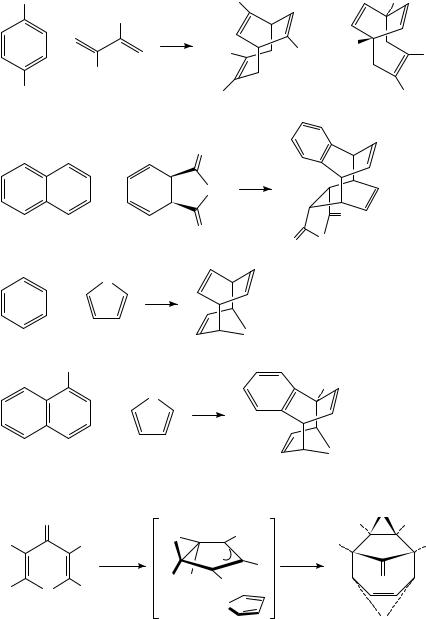
|
|
7. Application to the synthesis of complex molecules |
|
309 |
|||||||
|
CN |
|
|
|
|
|
Me |
|
|
Me |
|
|
|
|
Me |
|
|
|
|
|
|
|
|
|
|
+ |
|
hν |
|
|
Me |
CN |
+ NC |
|
|
|
|
|
|
|
|
|
Me |
||||
|
|
|
|
|
|
|
6 : 1 |
|
|||
|
|
|
|
|
|
|
|
|
|
||
|
|
Me |
|
|
|
|
|
|
|
||
|
|
|
|
|
|
|
|
|
|
||
|
Me |
|
|
|
|
|
Me |
|
|
Me |
|
|
|
|
|
|
|
|
(211a) |
|
|
(211b) |
|
|
|
|
|
|
|
|
O |
|
|
|
|
|
|
|
|
|
|
|
|
|
|
1 isomer |
|
|
|
|
+ |
|
|
|
hν |
|
|
|
|
|
|
|
|
|
|
O |
|
|
|
|
|
|
|
|
|
|
|
|
|
|
O |
|
|
|
|
|
|
|
|
|
O |
|
O |
|
|
|
|
|
|
|
|
|
|
O |
|
|
|
|
|
|
|
|
|
|
|
(212) |
|
|
|
|
|
|
|
|
|
|
|
|
|
|
|
|
|
|
O |
|
|
|
|
|
|
|
|
|
|
+ |
|
hν |
|
|
|
|
|
|
|
|
|
|
|
|
|
|
O |
|
|
|
|
|
|
|
|
|
|
|
(213) |
|
|
|
|
|
|
CN |
|
|
|
|
|
|
|
|
|
|
|
|
|
|
|
|
|
|
CN |
|
|
|
|
|
|
O |
|
|
|
|
|
|
|
|
|
|
+ |
|
|
|
hν |
|
|
|
|
|
|
|
|
|
|
|
|
|
O |
|
|
|
|
|
|
|
|
|
|
(214) |
|
|
|
|
|
|
|
|
|
SCHEME 48 |
|
|
|
|
|
|
O |
|
|
|
|
|
|
|
Me |
O |
|
|
|
|
|
|
|
Me |
|
Me |
|
||
Me |
|
Me |
|
O |
|
|
Me |
|
Me |
||
|
|
|
|
|
|
||||||
|
|
|
|
|
+ |
|
|
||||
|
|
|
hν, TFE |
|
|
|
[4+3] |
|
|
|
|
|
|
|
|
|
|
O− |
|
|
|
||
|
|
|
excess |
Me |
Me |
39 − 50% |
|
|
|
||
|
|
|
Me |
|
O |
|
|||||
Me |
O |
Me |
furan |
|
|
|
|||||
|
|
|
|
|
|
|
|||||
|
|
|
|
|
|
|
|
|
|||
|
|
|
|
|
|
|
O |
|
|
|
|
|
|
|
|
|
|
|
|
|
|
O |
(4) |
Further mechanistic work has revealed interesting solvent effects on diastereoselectivity103. A method for enriching isomer ratios in favor of the ‘trans’ or exo
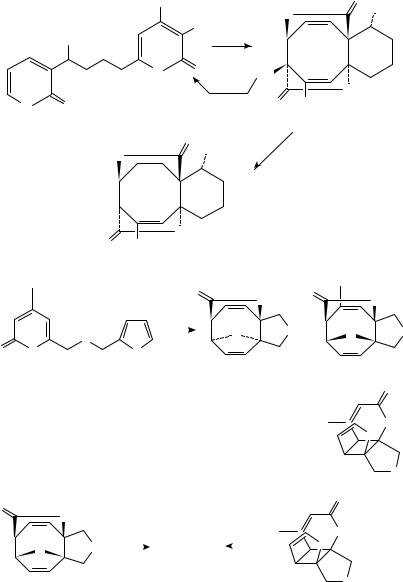
310 |
John M. Nuss and Frederick G. West |
diastereomer via a photo/thermal equilibration have also been reported. As a demonstration of its applicability to natural product targets containing the cyclooctane ring, the pyridone photodimerization process was employed as the key step in the construction of a taxane B-C ring synthon 216 (equation 11)104.
|
OMe |
|
|
O |
|
|
MeN |
OTBS |
|
|
|
|
||
|
|
Me |
|
|
|
|
|
|
|
|
OTBS |
hν |
|
|
|
|
MeOH |
|
|
|
N |
O |
Me |
|
|
Me |
|
|
NMe |
|
|
|
|
|
N |
O |
SiO2 |
O OMe |
|
Me |
|
|
|
(11) |
|
|
O |
PtO2 |
|
|
|
|
||
|
|
84% |
|
|
|
|
OTBS |
|
|
|
MeN |
H2 |
|
|
|
|
|
||
|
|
|
|
Me
NMe
|
|
|
O |
OMe |
|
|
|
|
|
|
|
|
|
|
|
|
(216) |
|
|
|
|
|
|||
|
|
|
|
|
|
|
hν |
|
O |
|
O |
|
|
|
|
|
|
|
|
|
|
||||
|
|
|
|
|
|
|
|
|
|
|
||
|
|
|
|
|
|
|
|
|
|
|
||
|
|
|
|
|
|
|
|
|
|
|
O |
|
O |
O |
O |
|
|
|
|
|
|
|
|
|
|
|
|
|
|
|
|
|
|
|
|
|||
|
|
O |
|
|
|
|
|
|
|
|||
|
|
(217) |
|
|
|
|
|
|
|
|
(218) |
|
|
|
overall |
|
|
|
|
|
|
|
|
|
|
solvent |
|
yield |
ratio 218:219:220 |
|
|
|
|
|
||||
PhCH3 |
|
15% |
|
1:1:1 |
|
|
|
|
|
|
|
|
H2 O |
|
59% |
|
2.1:2.3:1.0 |
|
|
|
|
|
|
|
|
aq. LiCl |
|
86% |
|
3.9:2.1:1.0 |
|
|
|
|
|
|
|
|
Et2 O/LiClO4 |
56% |
|
1.0:5.7:trace |
|
|
|
|
|
||||
acetone |
|
60% |
|
1:1:15 |
|
|
|
|
|
|
|
|
O |
|
O |
|
PhCH3 |
|
219 |
+ |
220 |
|
PhCH3 |
||
|
|
|
||||||||||
|
|
|
|
|||||||||
|
|
|
|
|||||||||
|
O |
O |
|
|
||||||||
|
|
∆ |
|
∆ |
||||||||
|
|
|
2 |
: |
1 |
|
||||||
|
|
|
|
|
|
|
|
|||||
(219)
SCHEME 49
O
O
O + |
O |
O |
|
|
|
|
(219) |
|
|
|
O |
+ |
|
O |
O |
|
|
|
|
O |
|
(220) |
|
|
O |
|
O
O
O
(220)
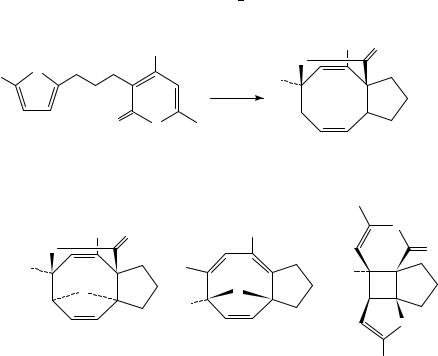
7. Application to the synthesis of complex molecules |
311 |
West and coworkers have reported a similar approach to functionalized cyclooctanoids
via the analogous |
[4 |
C 4]- |
photocycloaddition chemistry of 2-pyrones105. Rather than |
|||||
|
106 |
|
|
|||||
a pyrone |
|
pyrone |
dimerization process |
|
, this chemistry entails a crossed [4 C |
4]- |
||
|
|
|||||||
cycloaddition between a 2-pyrone chromophore and a spectator diene, typically a furan. For example, unsymmetrical ether 217 gave varying amounts of [4 C 4]- and [2 C 2]- cycloadducts 218, 219 and 220, depending upon conditions (Scheme 49). The best conversion to [4 C 4]-adducts was obtained by irradiation in the highly organized medium aqueous LiCl. The stereochemistry of exo and endo diastereomers 218 and 219 was rigorously assigned by heating either 219 or 220 in toluene to give identical ratios of both compounds, presumably through equilibration via [3,3]-shifts. It was also
found that extended irradiation led to a |
disappearance |
of 220, and this was shown |
to involve photocycloreversion to starting |
material and |
subsequent conversion to the |
photochemically inert [4C 4]-adducts. This isomerization process bears close resemblance to the photo/thermal equilibration noted by Sieburth and Lin103b. Related substrates gave similar results.
Substrates in which the furan was tethered at C-3 have also been examined107. These cases typically possessed ring-oxygenation at C-4, and the nature of this substituent proved to be important (Scheme 50). Examples with a free hydroxyl or a methyl ether at this position led to low yields of cycloadducts 221 224 and substantial amounts of polar by-products, possibly via competing solvent trapping pathways which ultimately lead to
O
R
O
R, R′ = H, Me
OR′ O
O
+
O
R
0−19%
(222a) R= R′ = H
(222b) R= Me, R′ = H
(222c) R= H, R′ = Me
OR′
hν
aq. MeOH
−10 °C − r.t.
O
combined yield = 36 −51%
OR′ O
O
 O
O R
R
0−7%
(221a) R= R′ = H
(221b) R= Me, R′ = H
(221c) R= H, R′ = Me
|
OR′ |
|
O |
|
|
|
|
|
|
|
O |
+ |
|
R′O |
|
O |
+ |
|
|
|
|
|
|
R |
|
|
|
|
|
|
O |
|
|
|
R |
|
0−39% |
|
6−15% |
(223a) |
R= R′ = H |
(224a) |
R= R′ = H |
(223b) |
R= Me, R′ = H |
(224b) |
R= Me, R′ = H |
(223c) |
R= H, R′ = Me |
(224c) |
R= H, R′ = Me |
SCHEME 50
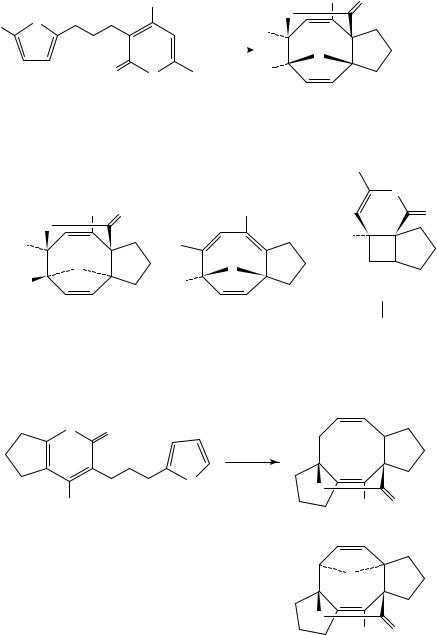
312 |
John M. Nuss and Frederick G. West |
O
R
O
R= H, Me; R′ = Ac,
Piv, Ts, Tf
Piv = Me3 CC(=O)
OR′ O
|
O |
+ |
O |
|
|
|
R |
43−74%
(222d) R= H, R′ = Ac
(222e) R= H, R′ = Piv
(222f) R= Me, R′ = Piv
(222g) R= H, R′ = Ts
(222h) R= H, R′ = Tf
O O
OPiv
(225)
OR′ |
|
|
O |
OR′ O |
|
|
|
|
|
|
|
hν |
|
|
|
|
aq. MeOH |
|
|
|
|
|
|
O |
|
|
−10 °C−r.t. |
||
|
|
|
||
O |
|
|
R |
|
|
|
|
|
|
|
combined |
9−24% |
||
|
yield = 67−91% |
|||
|
|
|
(221d) R= H, R′ = Ac |
|
|
|
|
(221e) R= H, R′ = Piv |
|
|
|
|
(221f) |
R= Me, R′ = Piv |
|
|
|
(221g) R= H, R′ = Ts |
|
|
|
|
(221h) R= H, R′ = Tf |
|
O
|
OR′ |
+ |
O |
|
|
|
R |
0−12%
(223d) R= H, R′ = Ac
(223e) R= H, R′ = Piv
(223f) R= Me, R′ = Piv
(223g) R= H, R′ = Ts
(223h) R= H, R′ = Tf
hν
aq. MeOH
O
+
O
R′O
+

 O
O
R
0−12%
(224d) R= H, R′ = Ac
(224e) R= H, R′ = Piv
(224f) R= Me, R′ = Piv
(224g) R= H, R′ = Ts
(224h) R= H, R′ = Tf
 O
O
O
OPiv O
(226a) 20%
O
O
OPiv O
(226b) 58%
SCHEME 50. (continued)
